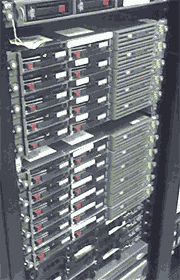Data Storage Solutions: Backup Software
Definition: Backup software is designed to backup one copy of
electronic data by making a duplicate copy of the data on the same or on
different media.
Why do I Need Backup Software?
Why not just copy the files you care about onto a blank CD and store it
somewhere safe? Thereís a good chance the irritation factor of doing it
repeatedly will result in the user neglecting to do it as often as they should.
Good backup software essentially makes the whole process a bit less bothersome
than it would be otherwise. How?
List of features you can expect to find in any decent backup software
- Data compression. Any backup software worth its salt will be able to compress
your data so it doesnít take up too much space on the final storage medium.
Savings can be significant. Some packages even allow you to alter the
compression values. In general, higher compression rates mean the backups take
more time to perform so, if compression settings can be altered, you can decide
for yourself what your preferred time\compression trade-off is.
- Encryption. Backup software should allow you to encrypt your data. Some of it
could be personal or commercially sensitive. Whether youíre backing up to an
external storage medium, or elsewhere on the network, when you create copies of
your data you multiply the chances of it falling into the wrong hands.
Encryption is essential to making it secure.
- It should be capable of performing incremental backups, meaning that only
files which have changed are actually backed up. Without this feature, youíd
have to manually sort out old and new files or just copy everything every time
you did a backup, of course taking up a great deal of time as you did so.
- Scheduling. Nearly all backup software will allow you to set schedules in
advance. That way, backups can be done automatically at a time thatís convenient
for you.
- Handling open files. If youíre working with important data on your PC
continuously and want that data to be backed up dynamically as itís being
changed.
- Controlling CPU usage. Backing up data can sometimes be processor-intensive,
interfering with other tasks you want to perform on your PC. Some backup
software allows you to throttle the demands it will make on the CPUís resources,
allowing you to get on with your work while the backup is performed
unobtrusively in the background.
- Help handling special files. For example, letís say you want to back up your
the bookmarks in your browser or your repository of emails. They exist as files
on your hard drive but do you know where they are? If you do, good for you, but
not everyone does. Backup software often comes with built-in procedures for
locating and backing up these special kinds of file.
- File Filtering. Almost all backup software will come with some kind of file
filtering mechanism that makes it easy to include or exclude specific types of
files when you do a backup. For example, letís say you want to include every
Microsoft Word or RTF file in your C: directory, or you want to backup
everything on your H: drive except mp3 files. With backup software, itís very
easy to do this; without it, youíd have to do a cumbersome search and copy
operation every time.
- Disc spanning. If you have a lot of data to backup, it probably isnít going to
fit on a single blank disc. You can try and save it all in little chunks which
you arrange in advance to be no larger than the media you have available, but
wouldnít it be nice to have jobs of any size chunked up for you, allowing you to
spread them across a number of discs. Thatís what disc-spanning is. Some
software will even allow you to make use of multiple drives if you have them.
That way, you insert a blank disc into each one, and the software moves to each
of them successively as the previous one fills up. It cuts out the need to
actively monitor the progress of each backup job, allowing the backup to be
completed automatically while you turn your attention elsewhere.
- Disaster Handling. Many backup packages allow you to prepare for extreme
situations, such as those where your computer is unbootable or where you cannot
access it directly. Some offer the option of creating an emergency boot disc
that will restore your computerís essential functions as well as any data you
have saved. Another common option is to allow you to save your data as an
executable file. That way, you can restore it with just a single click, whether
or not you have the backup software installed, even from a remote location.
- Handling open files. If you need to backup files dynamically while they are
being used, it can be a problem. Some backup software comes with special
facilities to get round it, however.
|
